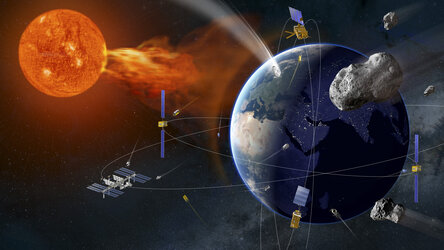Accept all cookies Accept only essential cookies See our Cookie Notice

About ESA
The European Space Agency (ESA) is Europe’s gateway to space. Its mission is to shape the development of Europe’s space capability and ensure that investment in space continues to deliver benefits to the citizens of Europe and the world.
Highlights
ESA - United space in Europe
This is ESA ESA facts Member States & Cooperating States Funding Director General Top management For Member State Delegations European vision European Space Policy ESA & EU Space Councils Responsibility & Sustainability Annual Report Calendar of meetings Corporate newsEstablishments & sites
ESA Headquarters ESA ESTEC ESA ESOC ESA ESRIN ESA EAC ESA ESAC Europe's Spaceport ESA ESEC ESA ECSAT Brussels Office Washington OfficeWorking with ESA
Business with ESA ESA Commercialisation Gateway Law at ESA Careers Cyber resilience at ESA IT at ESA Newsroom Partnerships Merchandising Licence Education Open Space Innovation Platform Integrity and Reporting Administrative Tribunal Health and SafetyMore about ESA
History ESA Historical Archives Exhibitions Publications Art & Culture ESA Merchandise Kids Diversity ESA Brand Centre ESA ChampionsLatest
Space in Member States
Find out more about space activities in our 23 Member States, and understand how ESA works together with their national agencies, institutions and organisations.
Science & Exploration
Exploring our Solar System and unlocking the secrets of the Universe
Go to topicAstronauts
Missions
Juice Euclid Webb Solar Orbiter BepiColombo Gaia ExoMars Cheops Exoplanet missions More missionsActivities
International Space Station Orion service module Gateway Concordia Caves & Pangaea BenefitsLatest
Space Safety
Protecting life and infrastructure on Earth and in orbit
Go to topicAsteroids
Asteroids and Planetary Defence Asteroid danger explained Flyeye telescope: asteroid detection Hera mission: asteroid deflection Near-Earth Object Coordination CentreSpace junk
About space debris Space debris by the numbers Space Environment Report In space refuelling, refurbishing and removingSafety from space
Clean Space ecodesign Zero Debris Technologies Space for Earth Supporting Sustainable DevelopmentLatest
Applications
Using space to benefit citizens and meet future challenges on Earth
Go to topicObserving the Earth
Observing the Earth Future EO Copernicus Meteorology Space for our climate Satellite missionsCommercialisation
ESA Commercialisation Gateway Open Space Innovation Platform Business Incubation ESA Space SolutionsLatest
Enabling & Support
Making space accessible and developing the technologies for the future
Go to topicBuilding missions
Space Engineering and Technology Test centre Laboratories Concurrent Design Facility Preparing for the future Shaping the Future Discovery and Preparation Advanced Concepts TeamSpace transportation
Space Transportation Ariane Vega Space Rider Future space transportation Boost! Europe's Spaceport Launches from Europe's Spaceport from 2012Latest

Houston, Texas
Thank you for liking
You have already liked this page, you can only like it once!
Houston, Texas, US, is featured in this image captured by the Copernicus Sentinel-1 mission.
The two identical Copernicus Sentinel-1 satellites carry radar instruments to image Earth’s surface. Images acquired with radar are interpreted by studying the intensity of the signal scattered back to the satellite – which is related to the roughness of the ground.
The colours of this week’s image come from the combination of two polarisations from the Copernicus Sentinel-1 radar mission, which have been converted into a single RGB image. Interpreting polarisation can help scientists analyse Earth’s surface.
In this composite image, captured on 21 June 2019, the city of Houston appears in shades of white and grey which contrasts with the yellow tones of the surrounding land and the dark blue waters of the Gulf of Mexico.
With a population of over two million and covering an area of over 1600 sq km, Houston is the state’s most populous city and the fourth largest city in the US.
Houston is dissected by a series of bayous passing. Buffalo Bayou can be seen cutting through Houston, before joining Galveston Bay visible at the bottom of the image. Galveston Bay is around 55 km long and around 30 km wide, making it the largest estuary in Texas. The shallow bay has an average depth of around 2 m, which is unusually shallow for its size.
The Port of Houston, which spreads across the northwest section of the bay, is one of the world’s largest ports, and many ships can be seen as multi coloured dots in the bottom-right of the image.
Houston is home to the NASA Lyndon B. Johnson Space Center, which lies west of Galveston Bay. The centre acts as NASA’s lead centre for astronaut training as well as the International Space Station mission operations. It was identified as mission control or simply ‘Houston’ during the Apollo, Gemini and Space Shuttle flights.
The centre also collaborates with other international facilities in a variety of scientific and engineering programmes related to human space flight and planetary exploration. The Johnson Space Center is where many ESA astronauts are sent as part of their training and preparation for future space missions. This is where Luca Parmitano, who recently returned to Earth, trained for his Beyond mission to the International Space Station.
This image is also available in the Earth from Space video programme.
-
CREDIT
contains modified Copernicus Sentinel data (2019), processed by ESA -
LICENCE
CC BY-SA 3.0 IGO or ESA Standard Licence
(content can be used under either licence)

Earth from Space: Houston, Texas

Hereford, Texas

Western Texas

Austin, Texas covered in snow















 Germany
Germany
 Austria
Austria
 Belgium
Belgium
 Denmark
Denmark
 Spain
Spain
 Estonia
Estonia
 Finland
Finland
 France
France
 Greece
Greece
 Hungary
Hungary
 Ireland
Ireland
 Italy
Italy
 Luxembourg
Luxembourg
 Norway
Norway
 The Netherlands
The Netherlands
 Poland
Poland
 Portugal
Portugal
 Czechia
Czechia
 Romania
Romania
 United Kingdom
United Kingdom
 Slovenia
Slovenia
 Sweden
Sweden
 Switzerland
Switzerland

























